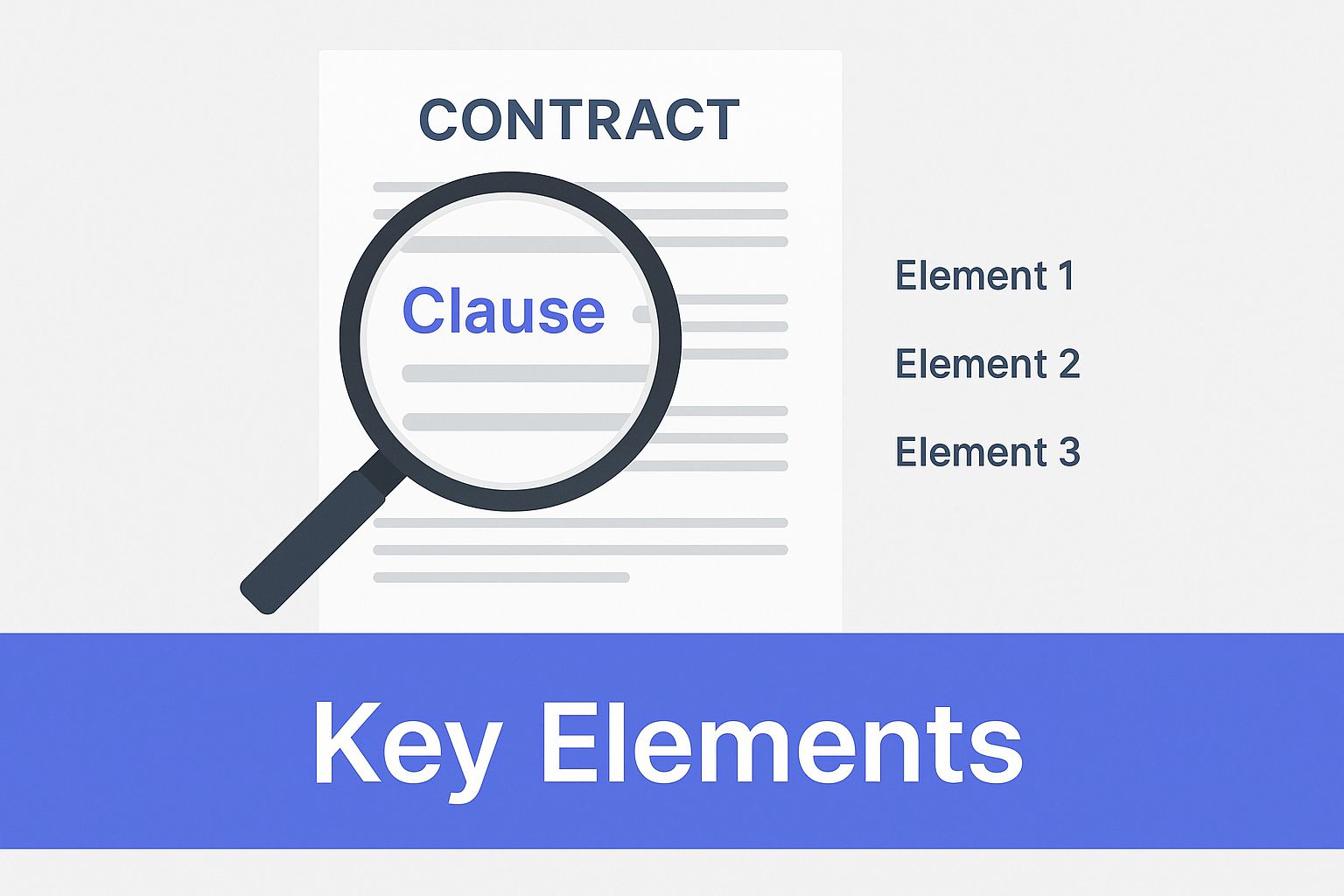
A force majeure clause is a powerful contractual tool that essentially hits the pause button on your obligations when a truly massive, unforeseen event makes it impossible to proceed. Think of it as a contract's emergency escape hatch for catastrophes like natural disasters, wars, or sudden government shutdowns.
This isn't a get-out-of-jail-free card for minor hassles or poor planning. It’s a critical legal shield designed for when genuine, uncontrollable disasters strike.
Understanding Force Majeure In Simple Terms

At its core, a force majeure clause is all about allocating risk. It’s a pre-negotiated answer to the big question: "What happens if an event completely beyond our control makes this deal impossible?" Without it, you could be found in breach of contract for failing to deliver goods, even if a hurricane just flattened your factory.
It’s like an insurance policy built right into your agreement, protecting you not from bad business decisions or a tough economy, but from overwhelming external forces you simply couldn't have predicted.
The Role Of Unforeseeability
A key ingredient here is that the event must be both unforeseeable and uncontrollable. A seasonal blizzard in a region known for heavy snow probably won't cut it. A sudden government embargo or a once-in-a-century flood, on the other hand, is exactly what this clause is for. The party trying to use the clause has to prove that this specific event directly stopped them from doing their part.
This concept is so fundamental that it’s a standard feature in most commercial deals. In fact, studies show that over 70% of large corporate contracts in sectors like manufacturing and construction contain detailed force majeure provisions. These clauses are absolutely vital for managing risk in industries that are vulnerable to disruption. You can explore more about these contractual trends and their significance in commercial law.
To help clarify what goes into a solid force majeure clause, here’s a quick breakdown of its essential components.
Key Elements of a Force Majeure Clause
| Element | Purpose | Example |
|---|---|---|
| Triggering Events | Clearly lists specific events that qualify. | "Acts of God, war, terrorism, pandemics, government-imposed shutdowns..." |
| Causation | Requires a direct link between the event and the inability to perform. | "...which directly prevents the party from fulfilling its obligations." |
| Notice Requirement | Sets a deadline for the affected party to inform the other. | "The affected party must provide written notice within 10 days of the event." |
| Mitigation Duty | Obligates the party to try to reduce the impact of the event. | "The party must use reasonable efforts to mitigate the effects of the event." |
| Remedies | Defines the consequences, such as suspension or termination. | "Obligations shall be suspended until the event ceases, or the contract may be terminated after 90 days." |
As you can see, a well-drafted clause provides a structured, predictable path forward when chaos erupts. It prevents costly legal battles by setting the rules of the game before a crisis hits. Depending on the situation, this can lead to a few different outcomes:
- Suspending contractual duties until the event passes.
- Extending deadlines to make up for the lost time.
- Terminating the contract entirely if performance becomes permanently impossible.
The Legal Foundation of Force Majeure Clauses
To really get what a force majeure clause is all about, you have to look at where it came from. This isn’t some new piece of corporate jargon; it’s a concept that’s been built up over centuries of legal thinking to make sure things stay fair when a contract becomes impossible to follow.
At its core, the clause tackles a fundamental question of fairness: who should take the hit when a totally unforeseeable event pulls the rug out from under an agreement?
The answer started coming together in English common law, laying down principles that still shape contracts today. Long before anyone was throwing around the term "force majeure," courts were wrestling with situations where fulfilling a contract was physically impossible. This led to legal ideas like the doctrine of impossibility.
The Birth of a Legal Doctrine
This whole idea was really cemented in a landmark 1863 English case, Taylor v. Caldwell. Here’s what happened: a contract was signed to rent out a music hall for a string of concerts. But before the first show, the hall accidentally burned to the ground, making it pretty hard to hold a concert there.
The court decided that both parties were off the hook. Their reasoning was that the entire contract was based on the unspoken assumption that the music hall would still be standing. Since it was destroyed by an event no one could control, performance was impossible, and the contract was essentially cancelled. You can read more about the historical context of this case and its huge impact on contract law. This was a game-changer, as it created a legal off-ramp when the very thing a contract is about simply ceases to exist.
Key Takeaway: The music hall burning down wasn't just an inconvenience; it made the whole point of the contract physically impossible. This case established that if an unforeseen event destroys the foundation of an agreement, the contract can be voided.
From Implied Conditions to Explicit Clauses
While the doctrine of impossibility offered a sort of default legal safety net, it had its limits and depended on a court’s interpretation. That left a lot of uncertainty on the table. Businesses needed a more direct way to handle risk without waiting for a judge to sort things out after a disaster already hit.
This need for more control led to the rise of the explicit force majeure clause we know today. Instead of leaving it to chance, parties started writing the "escape hatch" directly into their contracts.
This move was empowering. It allowed them to define for themselves what counts as an uncontrollable event and spell out exactly what happens if one occurs. It gives both sides a clearer, more predictable path for navigating disasters than just relying on old common law ideas. Often, the fallout is managed through specific dispute resolution methods, which you can learn more about in our guide to arbitration clauses.
Common Events That Trigger a Force Majeure Clause
While the legal theory is interesting, the real-world value of a force majeure clause comes down to one thing: knowing what specific events can actually trigger it. Think of these clauses not as vague safety nets, but as carefully written instructions for when a deal can be paused due to overwhelming, external disruptions.
For clarity, we can group these trigger events into a few common-sense categories.
Natural Disasters and "Acts of God"
The most intuitive category is natural disasters, often called "Acts of God." These are forces of nature completely outside of human control.
Some classic examples include:
- Hurricanes or typhoons
- Earthquakes and volcanic eruptions
- Floods, tsunamis, or severe droughts
- Unprecedented blizzards or wildfires
The key here is that the event must be truly catastrophic. A predictable seasonal rainstorm won’t cut it. But a historic flood that submerges your supplier’s factory and all access roads? That’s a much stronger candidate. The disruption must be a direct result of the disaster.
Human-Made and Governmental Disruptions
Beyond nature, certain human-made disruptions are also common triggers. These are large-scale events caused by people, but still far beyond the control of the parties involved in the contract.
This group includes things like:
- Acts of war, whether declared or not
- Terrorist attacks
- Widespread riots or civil unrest
- Major labor strikes that shut down an entire industry or region
Just as disruptive are governmental actions. This is when a government body imposes a new rule or order that makes it impossible to fulfill the contract.
Common examples are:
- Embargoes or trade sanctions that block the import or export of essential goods.
- Quarantines or government-mandated shutdowns, as we all saw during the COVID-19 pandemic.
- New laws that suddenly make performance of the contract illegal.
- Government seizure of property or materials (also known as expropriation).

As this image highlights, the specific wording used to describe these triggers is what really matters. It’s crucial to understand your rights and risks by focusing on the exact language in your contract.
To give you a clearer picture, here’s a breakdown of how these events are often categorized in legal documents.
Common Force Majeure Events by Category
| Category | Specific Examples | Key Consideration |
|---|---|---|
| Natural Disasters | Earthquakes, hurricanes, floods, volcanic eruptions, widespread fires, tsunamis, severe drought. | The event must be unforeseeable and of a magnitude that directly prevents performance. |
| Human-Caused Disruptions | Acts of war (declared or undeclared), terrorism, riots, industry-wide labor strikes, sabotage. | These events must be widespread and not caused by the party seeking to invoke the clause. |
| Governmental Actions | Embargoes, quarantines, new laws making performance illegal, government seizure of assets (expropriation). | The action must be a formal, binding order from a government entity that directly prohibits contract fulfillment. |
| Other Catastrophes | Pandemics, epidemics, widespread power grid failures, major infrastructure collapse. | Often covered by "catch-all" language, but courts may require them to be similar in scale to other listed events. |
This table shows why specificity is so important. A well-drafted clause leaves little room for argument about what counts as a qualifying event.
The Foreseeability Factor
A critical principle tying all of this together is foreseeability. For an event to qualify, it generally must have been unforeseeable when the contract was signed. If a party could have reasonably seen the disruption coming, they were expected to plan for it.
This is a high bar to clear, and it’s what separates a true force majeure event from a standard breach of contract, where one party simply fails to perform their duties without a valid, catastrophic excuse.
Key Takeaway: The less predictable and more severe an event is, the stronger the case for invoking force majeure. The focus is on impossibility, not just on something being more difficult or expensive.
Many contracts also include "catch-all" phrases like, "...or any other event beyond the reasonable control of the parties." While this seems to offer broad protection, courts often interpret such language narrowly. They usually require the unlisted event to be similar in nature to the specific ones already mentioned, which brings us back to the need for clear, well-defined language in any agreement.
How to Draft a Strong Force Majeure Clause
Relying on a generic, boilerplate force majeure clause is a bit like using a one-size-fits-all key for a custom-built lock—it almost never works when you actually need it to. A strong clause isn’t just copied and pasted; it’s carefully built to fit the specific context of your agreement. This custom approach is what gives you real protection when a crisis hits.
The first step is to get specific. A standard clause might vaguely mention "Acts of God," but a much stronger one spells out what that actually means for your business. If your company depends on shipping, for example, your clause should explicitly name events like port closures, embargoes, or widespread transportation strikes.
Define Trigger Events with Precision
The heart of any effective clause is a crystal-clear list of trigger events. Why? Because courts often interpret these provisions very narrowly. If an event isn't on the list, there's a good chance it won't be covered. Specificity is your best defense against a future dispute.
Instead of a vague term like "government action," think about drafting more precise language:
- Broaden the Scope: Use phrases like "governmental action, regulation, order, or restriction" to cover all sorts of state intervention.
- Include Economic Triggers: Courts are often hesitant to let market shifts excuse performance. You can get around this by explicitly adding language like, "the imposition of new tariffs or duties resulting in a cost increase of over 15%." This turns a general business risk into a defined, covered event.
- Address Modern Risks: It’s a different world now. Think about adding events like "widespread cyberattacks," "critical infrastructure failure," or "pandemics and epidemics," which have unfortunately become all too common.
A well-drafted clause anticipates the specific disruptions most likely to hit your industry. It's not just about listing random disasters; it's about pinpointing the exact events that would make it impossible for you to perform your side of the deal.
Establish Clear Procedures and Obligations
A strong clause does more than just list potential disasters. It lays out a clear roadmap for what happens next when a crisis actually occurs. Without this, both parties are left guessing, which is a recipe for conflict.
Your clause should clearly spell out these critical steps:
- Notice Requirement: Be exact about how and when the affected party must tell the other. For instance: "The affected party must provide written notice to the other party within 10 business days of the force majeure event's occurrence." This simple requirement prevents delays and keeps everything transparent.
- Duty to Mitigate: You should explicitly state that the affected party has a duty to mitigate damages. This means they must take reasonable steps to minimize the disruption's fallout. Including this shows good faith and prevents a party from using the clause to duck out of manageable inconveniences.
- Outline Consequences: Define what happens to the contract itself. Is it suspended? For how long? At what point can it be terminated? For example: "Contractual obligations will be suspended for the duration of the event. If the event persists for more than 90 consecutive days, either party may terminate the agreement upon written notice."
Negotiate a Fair Allocation of Risk
Finally, remember that a contract is a two-way street. When you're looking at a clause proposed by the other side, scrutinize it. Make sure it allocates risk fairly. If it's overly broad and one-sided, it could leave your business completely exposed.
Look for language that balances responsibilities. For instance, a shared-risk provision for something like tariff hikes can be a fair compromise. A clause might state that a contractor absorbs the first 10% of a cost increase, with any amount beyond that being shared or passed on to the owner. This kind of collaborative approach not only fosters a better working relationship but also gives everyone a clear, predictable way to handle unexpected economic shocks.
Navigating a Force Majeure Claim in the Real World

Knowing what a force majeure clause says is one thing. Actually using it when a crisis hits? That’s a whole different ballgame. Invoking this provision isn't just about sending an email; it kicks off a formal process that demands precision and quick thinking from the moment things go sideways.
Let’s say your main supplier overseas gets shut down by a sudden, government-mandated port closure. Shipments of a component you absolutely need for your product have ground to a halt. Suddenly, you can’t deliver to your own clients. This is the moment a force majeure clause goes from a hypothetical safety net to your real-world crisis playbook.
The Critical First Steps
Your first move is non-negotiable: you must send a formal written notice to the other party. Almost every force majeure clause includes strict notification deadlines, sometimes as short as 10 or 15 days after the event starts. If you miss that window, your claim could be dead on arrival, no matter how legitimate your reason.
At the same time, you need to start documenting everything. Meticulously. Gather every piece of evidence you can find that proves:
- The event actually happened (think government orders, official news reports).
- The event is the direct cause of your inability to perform.
- The timing of the event and its ongoing impact on your operations.
This evidence is the backbone of your claim. It’s what you’ll rely on in any negotiations or legal challenges down the road. Proper record-keeping is a huge part of effective https://legaldocumentsimplifier.com/blog/contract-compliance-management, as it shows you’re following the agreed-upon rules.
The Duty to Mitigate Damages
Triggering a force majeure clause doesn't give you a free pass to sit back and do nothing. The law—and most contracts—imposes a duty to mitigate. In simple terms, this means you have to take every reasonable step to minimize the fallout and reduce the damages for everyone involved.
Key Takeaway: The duty to mitigate is all about proactive problem-solving. A court won't just look at whether the event happened; it will want to see that you genuinely tried to work around the problem, not just use it as an excuse to stop performing.
Going back to our supply chain example, mitigation could look like this:
- Immediately scrambling to find alternative domestic suppliers, even if they cost more.
- Actively exploring different shipping routes that aren't affected by the port closure.
- Keeping your client in the loop with transparent updates about delays and revised timelines.
If you can't show you made these kinds of reasonable efforts, your position gets a lot weaker.
Ultimately, the goal is to figure out what happens to the contract. Depending on the clause’s wording and how long the crisis lasts, the outcome might be a temporary suspension of your duties, a renegotiation of deadlines, or—if things are truly at a permanent standstill—the termination of the contract altogether.
Frequently Asked Questions About Force Majeure
Even when you have a good handle on force majeure, certain situations can still throw you a curveball. Let's walk through some of the most common questions that pop up and clarify how these clauses work in the real world.
Does It Cover Economic Downturns?
Generally, the answer is no. A what is force majeure clause is built to handle unforeseeable, external events that make it physically impossible to follow through on a contract—not just more expensive or less profitable. Things like recessions, inflation, or sudden market slumps are typically seen as the normal risks of doing business, which companies are expected to anticipate and navigate.
Unless your contract is unusually specific and explicitly names "economic collapse" or a similar term as a trigger, courts are highly unlikely to let financial hardship be a valid excuse. The focus is almost always on catastrophic events that are truly outside a party's control, not the predictable tides of the market. This very point was made clear in the notable case of Seaboard Lumber Co. v. United States, where a general downturn was rejected as a valid defense.
Force Majeure vs. The Doctrine of Frustration
While these two legal ideas tackle similar problems, they are not the same thing. Here’s a simple way to think about it: force majeure is a proactive tool you write into your contract, while the doctrine of frustration is a reactive argument you make when your contract doesn't have such a clause.
- Force Majeure Clause: This is a specific provision that both parties negotiate and agree to. It lays out the trigger events and the exact steps to take when one occurs. It’s a pre-planned rulebook for allocating risk.
- Doctrine of Frustration (or Impossibility): This is a common law principle a court can apply even without a force majeure clause. It comes into play when an unforeseen event makes the contract's entire purpose radically different from what was intended, or flat-out impossible to achieve. In these rare cases, the contract is essentially terminated.
In short, a force majeure clause is your custom-made plan for disasters. The doctrine of frustration is the legal system's emergency brake when no plan exists.
What If an Event Is Not Listed?
This is where the fine print of your clause becomes absolutely critical. Most contracts tend to fall into one of two buckets.
If your clause only lists specific, named events (like "fire, flood, earthquake, war"), then anything not on that list won't be covered. This is called a strict interpretation, a legal approach that was upheld in cases like Kel Kim Corp. v. Central Markets, Inc.
However, many clauses include a "catch-all" phrase such as "...or any other event beyond the reasonable control of the parties." This can create an opening to claim force majeure for something that wasn't specifically listed.
Crucial Point: Even with a catch-all phrase, you can't just throw up your hands at any old disruption. Courts usually interpret these phrases narrowly. You'll have to show that the unlisted event is similar in type and severity to the ones that are listed—a legal principle known as ejusdem generis.
Do I Still Have to Try After an Event?
Yes, absolutely. A force majeure event isn't a free pass to walk away from your obligations entirely. You have a duty to mitigate.
This legal responsibility means the affected party must take all reasonable steps to minimize the disruption and limit the damage. For example, if your main supplier gets shut down by a flood, you're expected to make a good-faith effort to find an alternative—even if it's more expensive or less convenient.
Failing to show that you tried to mitigate the problem can seriously weaken, or even completely invalidate, your force majeure claim. You need to be able to prove that performance was truly impossible, not just a major headache, and that you did everything you reasonably could to find a way forward.
Navigating the specifics of a force majeure clause can be complex, and the language matters immensely. Legal Document Simplifier uses powerful AI to scan your contracts and highlight these critical provisions, translating dense legal text into clear, actionable summaries. Upload your document today and instantly understand your risks and obligations. Get started at https://legaldocumentsimplifier.com.